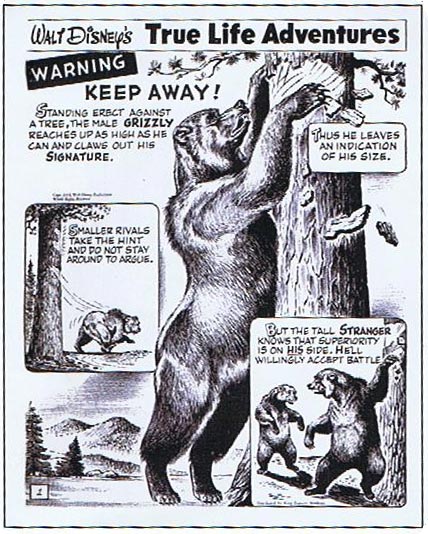First episode of 'Walt Disney's True Life Adventures' (14 March 1955).
George Wheeler was a Disney animator and comic artist, best known for drawing the 'True Life Adventures' (1955-1973) newspaper feature, based on Walt Disney's nature documentary series of the same name. This educational animal comic was drawn in a realistic style and appeared in several newspapers and international Disney magazines.
Early life and career
George Wheeler was born in 1919. Not much is known about his early years, except that his mother's family came from Elko, Nevada, and Wheeler spent many of his childhood days there. He worked as an inbetweener at the Walt Disney Studios in the 1950s, and began his association with the comics department in 1955.
True Life Adventures
In 1948, Walt Disney launched a series of live-action animal documentaries named 'Walt Disney's True Life Adventures'. Disney was commonly associated with fiction films - animated or live-action - so documentaries were quite a surprising career move. The films were mostly directed by James Algar, with production by Disney director Ben Sharpsteen and Walt's nephew Roy E. Disney. It was the first project to be distributed by Buena Vista, who'd remain Disney's long-time film distributors for decades. In total 14 entries were made: 'Seal Island' (1948), 'In Beaver Valley' (1950), 'Nature's Half Acre' (1951), 'The Olympic Elk' (1952), 'The Water Birds' (1952), 'Bear Country' (1953), 'Prowlers of the Everglades' (1953), 'The Living Desert' (1953), 'The Vanishing Prairie' (1954), 'The African Lion' (1955), 'Secrets of Life' (1956), 'Perri' (1957), 'White Wilderness' (1958) and 'Jungle Cat' (1960).
The series showed real animals in their natural environment. While the tone was educational, the footage was often tampered with to make scenes more entertaining. Disney and his crew would play with the editing or add background music to make certain scenes more dramatic and/or comedic. A famous scene in 'The Living Desert' shows two scorpions fighting one another, but banjo music is added to make it appear as if they are line-dancing. The most controversial addition was a scene in 'White Wilderness', where the narrator suggests that lemmings, at one point in their life, all start migrating for apparently no specific reason. In their mass hysterical behavior, the little critters even jump off cliffs to cross the ocean. In reality, lemmings show no such behavior in real life. The camera crew merely drove them over cliffs themselves, for dramatic effect. The misconception that lemmings have a suicidal streak is still believed by many people today and frequently referenced in popular culture.
'Walt Disney's True Life Adventures' was quite successful for a series of nature documentaries. Disney's fame and brand recognition, alongside the entertaining style, arguably helped. 'Seal Island', 'In Beaver Valley', 'Nature's Half-Acre', 'Water Birds' and 'Bear Country' each won the Academy Award for Best Short Subject (Two-Reel). 'The Living Desert', 'The Vanishing Prairie' and 'White Wilderness' all won the Oscar for Best Documentary Feature. 'The Living Desert', 'The Vanishing Prairie','The African Lion' and 'In Beaver Valley' received a Silver Bear for Best Documentary at the Festival of Berlin. 'The Living Desert' also won a special Golden Globe and the International Prize at the Festival of Cannes. In 2000, the picture was inducted in the National Film Registry and preserved for all time for being "culturally, historically and/or aesthetically significant." Originally released in theaters, the True Life Adventures were broadcast on Walt Disney's TV shows too. Clips from all films were compiled into an anthology film, 'Walt Disney's True Life Adventures' (1975).
'Walt Disney's True Life Adventures' of 30 October 1956 and 3 November 1966 (starring Dumbo!).
Comic strip adaptation
Like all Disney media, even 'True Life Adventures' inspired merchandising. A series of books were brought out with beautiful color photographs. In March 1955 a daily newspaper comic was created for King Features Syndicate, written by Disney animator Dick Huemer, while inbetweener George Wheeler made the illustrations. Huemer had written scripts for comics before, namely Mel Cummin's 'Good Time Guy' (1928-1929) and Paul Murry's 'The Adventures of Buck O'Rue' (1951). Since the 'True Life Adventures' had no actual story, the comics were basically realistic drawings of real-life animals, with biological trivia added next to them. Although 'True Life Adventures' ended its theatrical run in 1960, the comic strip kept running until 14 April 1973. In addition to the newspaper feature, August Lenox drew educational comic stories about animals under the 'True Life Adventures' banner for the comic books by Western Publishing in 1955-1956. Wheeler also illustrated children's books based on Disney films like 'Cinderella' (1954), published by the Whitman Publishing Company.
Further animation work
In 1968, Wheeler went to another well known animation studio, Hanna-Barbera, where he worked as a lay-out artist and character designer on popular series like 'The Flintstones', 'Scooby-Doo' and more forgettable shows like 'The Harlem Globetrotters'. He was briefly active at Filmation too. Between 1972 and 1974 Wheeler made lay-outs for their TV shows, among them 'Star Trek - The Animated Series'. Afterwards he returned to Hanna-Barbera where he stayed until 1979. Wheeler was also a lay-out artist on Chuck Jones' 'Rikki-Tikki-Tavi' (1975), an animated short based on Rudyard Kipling's stories.






